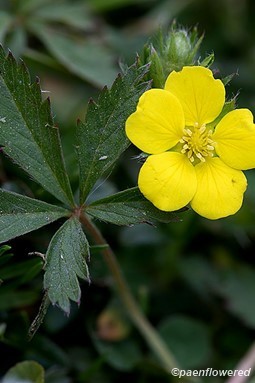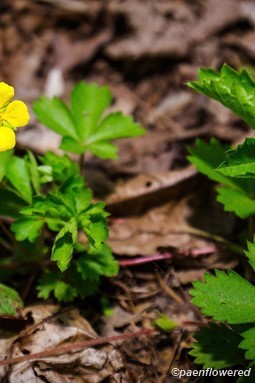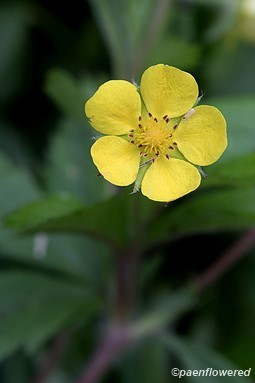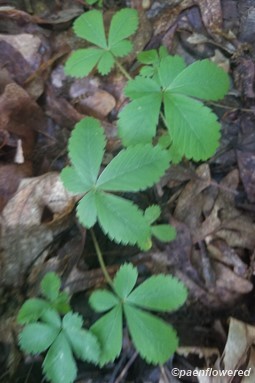Potentilla canadensis
Potentilla canadensis dwarf cinquefoil
This native cinquefoil has prostrate stems that run on the ground and root at the nodes. The flowers and leaves rise from the runners on separate stalks. Dwarf cinquefoil features palmately compound leaves, each with 5 narrowly egg-shaped leaflets with sharp teeth on upper halves of the leaflets. From May To July, the plant produces small yellow flowers with 5 rounded petals, surrounding a flattened center with 20 or more stamens, attracting pollinators such as flies and mason bees.
This plant thrives best in full sun to partial shade, well-drained soil, and dry to moist environments such as open fields and woodlands. Its stoloniferous growth allows it to spread across the ground, forming dense mats. P. canadensis is often mistaken for Fragaria virginica (wild strawberry), which has white-petaled flowers, in contrast to the yellow-petaled blooms of cinquefoils. Dwarf cinquefoil more closely resembles common cinquefoil (P. simplex), however dwarf cinquefoil tends to grow lower to the ground, while P. simplex species tend to have slightly larger flowers and longer compound leaves, which may have hairy undersides. Another notable difference between the two is that in dwarf cinquefoil the lowest flower develops in the axil of the first well-developed leaf, while in common cinquefoil the lowest flower occurs in the second well-developed leaf.
Habitat & Range
Common in dry, open woods and fields. Prefers full sun to partial shade, and well-drained soils with neutral pH.
Present throughout the state.
Range: Native to eastern North America, ranging from Ontario and Nova Scotia in Canada down through the eastern and central United States, including states like Pennsylvania, New York, Virginia, North Carolina, Tennessee, and Missouri.
| EMP: | UPL |
|---|---|
| NCNE: | UPL |
Phenology
Flowers May through July.
Characteristics
Inflorescence widely spaced solitary flowers on axillary peduncles
Flowers 5 small rounded yellow petals, 5 green pointed hairy sepals shorter than petals; numerous stamens; 10-15 mm across; lowest flower developing in the axil of the first-developed leaf
Leaves leaves compound, palmately 5-foliate; leaflets reversely egg-shaped (obovate), upper (distal) half of leaflets is sharply toothed, and lower is smooth
Stems stoloniferous; erect, becoming prostrate; covered with silvery-downy hairs; often roots at nodes; green when young turning reddish with age
Fruit cluster(1 to 5) of achenes surrounded by persistent calyx; self-seeding
Height 2 to 6 inches
Similar Species
Potentilla simplex
terminal leaflet usually ovate; with teeth extending at least half way to the base while P. canadensis terminal leaflet usually obovate; with teeth extending less than half way to the base
first flower arises from the second node on the stem, while in P. canadensis the first flower arises from the first node on the stem
Plant Codes
S-rank: S5 (Secure)
G-rank: G5 (Secure)
Ecology
Main pollinators include small bees and flies. Acts as a host plant for grizzled skippers (both in the larval and adult stage) and cinquefoil bud gall wasps. Foliage is eaten by small mammals such as rabbits and groundhogs who also aid in seed disperal.












Comments
Have you spotted this plant in your area? We'd love to hear about your experience! Share your comments or questions about the plant below. Comments are moderated before posting.